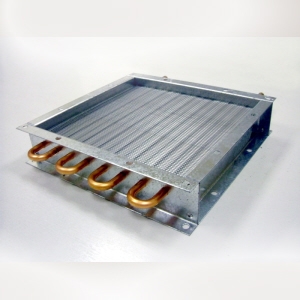Water is the most abundant medium for heating and cooling applications. Luckily there's a water coil from SPC for just about any hot or cold water application.
We have over 30 years' experience in the design and manufacture of coils. There are few, if any, design and specification issues that we have not addressed before. When you specify a coil from SPC, you're sourcing it from the coil experts.
Efficient transmitters of heat energy
A water coil is a heat exchanger. It transfers heat energy between water and another medium (usually air) as quickly and efficiently as possible. Heating coils transmit energy from hot water to a stream of air, cooling coils extract energy from an air stream and add it to cold water.
The coils themselves consist of a matrix of copper tubes through which the water flows. The tubes run back and forth between two end-plates in an arrangement that lets the air flow perpendicular to the tubes. The tubes pass through - and are attached to - a layered array of thin metal plates known as fins. The fins are also perpendicular to the tubes, which means they lie parallel to the direction of air flow. The air flows between them. Energy either passes from the water via the tubes and fins to the air, or from the air via the fins and tubes to the water.
Economy CoilThe efficiency of this arrangement depends on the types and thickness of metal used, the integrity of the bond between tubes and fins, the number and the layout of the tubes and fins, the air flow, and the water flow. Our skill lies in pulling all those elements together to make a coil that's right for your application.
Types of water coil
Heating coils are characterised by the temperature of the water that passes through them.
Low-grade hot water (LGHW) - typically below 60°C. LGHW is associated with condensing boilers or waste water that has already lost much of its heat.
Low-pressure hot water (LPHW) - typically between 60°C and 110°C. LPHW is the most common medium for coil heat exchangers.
Medium-temperature hot water (MTHW) - typically between 110°C and 130°C. To keep water liquid above 100°C requires additional pressure. 120°C requires a pressure of 200kPa (2 bar).
High-temperature hot water (HTHW) - typically above 130°C. The most demanding condition for coil design. 140°C requires a pressure of 360kPa (3.6 bar).
When discussing heating coils, the terms 'low-', 'medium-', and 'high-temperature' are interchangeable with 'low-', 'medium-', and 'high-pressure'.
Cooling coils are characterised by the amount and type of anti-freeze used.
Pure water is the most common medium. It's used in applications that do not require the water temperature to fall below 0°C, or where there's no risk of freezing.
The introduction of anti-freeze adversely affects the heat transferring properties of water. The increased viscosity slows flow rates through the coil. Anti-freeze concentrations above 30% require specialist pump equipment. They are not recommended.
Ethylene glycol solution (EGS) is the more efficient and the most widely-used of the two anti-freeze solutions.
Propylene glycol solution (PGS) is always used in the food industry because it is less toxic.
Cooling coils are supplied with a drain pan when condensation from latent cooling is anticipated. Where physical parameters constrain the surface area of the coil, moisture eliminators can be incorporated to prevent moisture carry-over.


